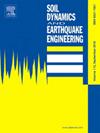Measurement of dynamic properties of rubber-sand mixtures across wide strain amplitudes by combined resonant column and cyclic simple shear tests
IF 4.2
2区 工程技术
Q1 ENGINEERING, GEOLOGICAL
引用次数: 0
Abstract
The systematic exploration of the dynamic characteristics of various rubber-sand mixtures (RSM) across a wide range of strain amplitudes (10−6∼10−1) addresses a pivotal challenge in the deployment of recycled waste tires as an economical, energy-absorbing material in geotechnical earthquake engineering. This study aims to elucidate the dynamic characteristics of this distinctive soil under wide strains and explores the appropriate particle size selection, optimal ratio, and initial state parameters for RSM as a geotechnical seismic isolation system. The investigation initiates with a series of resonant column tests to determine the dynamic shear modulus and damping ratio of RSM at small strain amplitudes, considering different rubber contents (RC), particle size ratios (PSR), and confining pressures. Subsequently, cyclic simple shear tests with larger strain amplitudes were conducted to examine the dynamic properties of RSM across a wide range of shear strains. The results indicate that: The PSR of rubber to sand significantly influences the dynamic parameters of RSM at small strains, resulting in a 3–4 fold change in the maximum dynamic shear modulus, which is attenuated at large strains, and exhibiting a coupling effect between the PSR and RC on the dynamic shear modulus and damping ratio. Over a wide strain amplitude range, including rubber particles enhances the damping characteristics of sandy soil. At small strains, the damping ratio gradually increases with the rise in RC; however, under large strain conditions, the variation trend of the damping ratio depends on the specific RC. when the RC increases from 0 % to 25 %, the dynamic shear modulus of RSM decreases significantly. As the RC further increases to 30 %, the extent of reduction in the dynamic shear modulus decreases significantly. These findings on the dynamic behavior of RSM under different strain conditions are crucial for guiding future theoretical research and engineering applications in seismic protection.
用组合式共振柱和循环单剪试验测量橡胶-砂混合料宽应变幅值的动力特性
系统地探索各种橡胶-砂混合物(RSM)在宽应变幅(10−6 ~ 10−1)范围内的动态特性,解决了在岩土地震工程中使用回收废轮胎作为经济、吸能材料的关键挑战。本研究旨在阐明这种独特的土在宽应变下的动力特性,并探讨RSM作为岩土隔震系统的合适粒径选择、最佳配比和初始状态参数。在考虑不同橡胶含量(RC)、粒径比(PSR)和围压的情况下,通过一系列共振柱试验,确定小应变幅下RSM的动剪切模量和阻尼比。随后,进行了较大应变幅的循环单剪试验,以检验RSM在大范围剪切应变下的动态特性。结果表明:在小应变下,橡胶对砂的PSR显著影响RSM的动态参数,导致最大动剪切模量变化3-4倍,在大应变下减弱,PSR与RC对动剪切模量和阻尼比表现出耦合效应。在较宽的应变幅值范围内,含橡胶颗粒增强了砂土的阻尼特性。在小应变下,随着RC的增大,阻尼比逐渐增大;而在大应变条件下,阻尼比的变化趋势取决于具体的RC。当RC含量从0%增加到25%时,RSM的动剪切模量显著降低。当RC进一步增加到30%时,动剪切模量的减小幅度显著减小。这些研究结果对于指导未来抗震理论研究和工程应用具有重要意义。
本文章由计算机程序翻译,如有差异,请以英文原文为准。
求助全文
约1分钟内获得全文
求助全文
来源期刊

Soil Dynamics and Earthquake Engineering
工程技术-地球科学综合
CiteScore
7.50
自引率
15.00%
发文量
446
审稿时长
8 months
期刊介绍:
The journal aims to encourage and enhance the role of mechanics and other disciplines as they relate to earthquake engineering by providing opportunities for the publication of the work of applied mathematicians, engineers and other applied scientists involved in solving problems closely related to the field of earthquake engineering and geotechnical earthquake engineering.
Emphasis is placed on new concepts and techniques, but case histories will also be published if they enhance the presentation and understanding of new technical concepts.
 求助内容:
求助内容: 应助结果提醒方式:
应助结果提醒方式:


